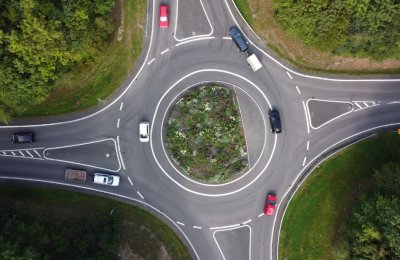Roundabouts
Roundabouts are circular intersections in which all vehicles travel in a counter-clockwise direction. Compared with signalized and stop controlled intersections, roundabouts are safer, lower maintenance, more efficient, better for the environment and more aesthetically pleasing.
Roundabout safety
Roundabouts are the safest type of at-grade intersection. They create slower speeds, fewer conflict points for pedestrians and motorists, and reduced collision angles compared to stop sign or traffic signal control. A national study of intersections converted to modern roundabouts had the following significant findings:
- A reduction in collisions of all types of 40%.
- A reduction in injury collisions of 75%.
- A reduction in fatal and incapacitating collisions of about 90%.
Additionally, roundabouts have been proven to cause the following:
- Reduced delays: since motorists do not always have to stop, delays and queues are usually less compared to STOP sign or traffic signal control especially at high traffic flows.
- Environmental benefits: with reduced delay, roundabouts lessen noise, air pollution and fuel consumption. In one study, replacing a signalized intersection with a roundabout reduced carbon monoxide emissions by 29% and nitrous oxide emissions by 21%. Constructing roundabouts in place of traffic signals can reduce fuel consumption by about 30%. This is likely to become an increasingly important consideration in the future. Roundabouts also provide opportunities for traffic calming and speed transition, as well as landscaping and gateway treatments.
- Bicyclist safety: roundabouts offer a more bicycle friendly experience than traditional intersections.
- Low maintenance: roundabouts eliminate maintenance and electricity costs associated with traffic signals.
- Capacity: by yielding at the entry rather than stopping and waiting for a green light, the delay is significantly reduced.
- Aesthetics: the central island provides an opportunity to beautify the intersection with landscaping.
How do roundabouts affect traffic flow?
Certainly a number of studies conducted by the Traffic Institute and others have reported significant improvements in traffic flow following conversion of traditional intersections to roundabouts. A recent study documented missed opportunities to improve traffic flow and safety at 10 urban intersections suitable for roundabouts where either traffic signals were installed or major modifications were made to signalized intersections. It was estimated that the use of roundabouts instead of traffic signals at these 10 intersections would have reduced vehicle delays by
62-74%. This is equivalent to approximately 325,000 fewer hours of vehicle delay on an annual basis.
Can roundabouts accommodate larger vehicles?
Yes. To accommodate vehicles with large turning radii such as trucks, buses, and tractor-trailers, roundabouts provide an area between the circulatory roadway and the central island, known as a truck apron, over which the rear wheels of these vehicles can safely track. The truck apron generally is composed of a different colored material than the paved surface, usually a reddish colored concrete, to discourage routine use by smaller vehicles.
Are roundabouts safe for pedestrians?
Generally, roundabouts are safer for pedestrians than traditional intersections. In a roundabout, pedestrians walk on sidewalks around the perimeter of the circulatory roadway. If it is necessary for pedestrians to cross the roadway, they cross only one direction of traffic at a time. In addition, crossing distances are relatively short, and traffic speeds are lower than at traditional intersections. Studies in Europe indicate that, on average, converting conventional intersections to roundabouts can reduce pedestrian crashes by about 75%. Single-lane roundabouts, in particular, have been reported to involve substantially lower pedestrian crash rates than comparable intersections with traffic signals.
Things to Remember When Driving Through a roundabout:
- Slow down when approaching the roundabout.
- Yield to pedestrians in the entry crosswalk.
- Look left, and yield to all traffic in the roundabout.
- Enter only when there is a safe gap in traffic.
- Make a right turn into the roundabout. Traffic flows counterclockwise.
- Just prior to exiting, signal, and watch for pedestrians.
- Yield to pedestrians in the exit crosswalk.
- Stay in your lane; do not change lanes.
- Do not stop in the roundabout.
For more ways of learning how roundabouts affect traffic flow, visit the supporting documents below!

